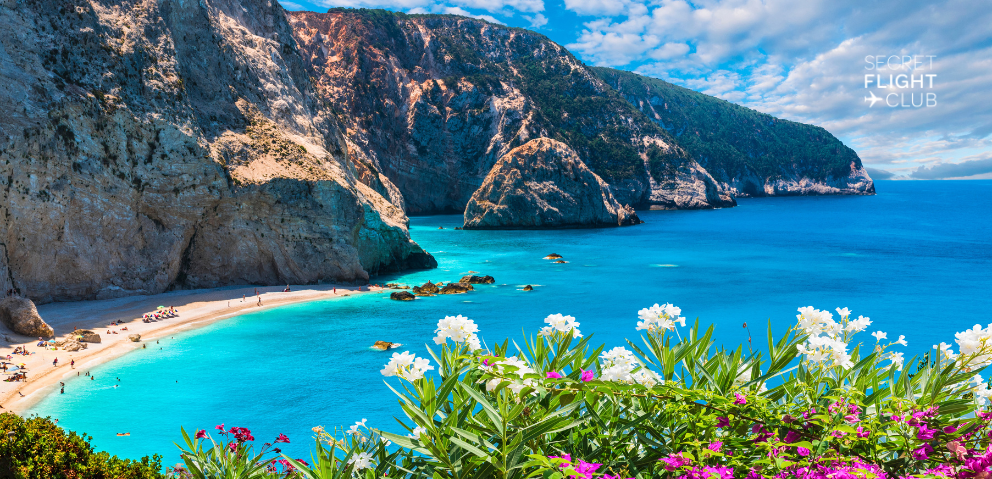Awesome Beaches in Europe: 4 Options For Your Travel Diary
05 August 2024

Europe's coastlines are a treasure trove of stunning beaches, offering travellers a diverse array of seaside experiences. From the sun-soaked Mediterranean to the rugged Atlantic shores, the continent boasts some of the world's most beautiful and inviting stretches of sand. These coastal gems have an influence on millions of holiday-makers each year, drawing them in with promises of relaxation, adventure, and unforgettable memories.
We're showcasing a carefully curated selection of top coastal destinations. Discover hidden coves in Greece, explore pristine Arctic beaches in Norway, and bask in the Mediterranean sun on Italian and Spanish shores. Whether you're looking for white sand beaches, secluded bays, or vibrant coastal cities, this article serves as an essential resource to plan the perfect European beach getaway.
Navagio Beach, Greece

Navagio Beach, also known as Shipwreck Beach, is a picture-perfect cove on the coast of Zakynthos, Greece. This stunning location has an influence on travellers from around the world, drawing them in with its breath taking beauty and unique features.
Navagio Beach location and access
Situated on the north-western coast of Zakynthos in the Ionian Sea, Navagio Beach is accessible only by boat. Visitors can embark on boat trips from various points on the island, including Zakynthos town, Porto Vromi, and Agios Nikolaos. The journey to the beach takes approximately 20 minutes, offering picturesque views along the way.
Navagio Beach unique features
The beach's most striking feature is the rusty shipwreck of MV Panagiotis, which ran aground in 1980. This abandoned vessel, nestled on the white sand, creates a captivating contrast against the turquoise waters and towering limestone cliffs. The surrounding sulphur caves contribute to the intense blue hue of the sea, making it a photographer's paradise.
Best time to visit Navagio Beach
The ideal time to visit Navagio Beach is between May and October, with July and August being the most popular months. For the best experience, arrive early in the morning when the sea is calm and crowds are fewer. Midday offers optimal lighting conditions for photography, as the sun illuminates the entire beach, enhancing its natural beauty. Visitors should be aware that the western coast of Zakynthos can be windy, potentially affecting boat access to the beach.
Haukland Beach, Norway

Nestled in the heart of the Lofoten Islands, Haukland Beach stands as a testament to Norway's breath taking coastal beauty. This stunning stretch of white sand, located about a 10-minute drive from Leknes on the north side of Vestvågøy, has earned its reputation as one of Norway's finest beaches.
Haukland Beach scenery
The beach's pristine white sand creates a striking contrast against the rugged landscape, with dramatic cliffs and mountains serving as a majestic backdrop. Crystal-clear turquoise waters lap gently at the shore, offering visitors a mesmerising vista that seems almost surreal in its Arctic setting. The interplay of these elements – white sand, azure waters, and towering peaks – forms a landscape that captivates photographers and nature enthusiasts alike.
Haukland Beach activities
Despite its northern location, Haukland Beach offers a variety of activities for visitors to enjoy. Swimming is popular during the milder summer months, though the water remains quite cold. Kayaking and stand-up paddleboarding provide excellent ways to explore the coastline, while hiking trails in the surrounding area lead to breathtaking viewpoints. For the more adventurous, the nearby mountains offer rock climbing opportunities. Birdwatchers will appreciate the diverse seabird population that frequents the area.
Haukland Beach weather conditions
The Lofoten Islands experience a maritime climate, resulting in variable weather conditions at Haukland Beach. Summers are generally mild, with average temperatures around 15°C (59°F), making it the ideal time for beach activities. Winters, however, can be cold and snowy, with temperatures often dropping below freezing. Visitors should be prepared for changeable weather and dress accordingly, regardless of the season. The beach's beauty persists year-round, offering unique experiences from midnight sun in summer to potential Northern Lights sightings in winter.
Cala Goloritzè, Sardinia, Italy

Cala Goloritzè location and access
Cala Goloritzè, a picturesque cove on Sardinia's northeastern coast, is part of the stunning Golfo di Orosei. Located about 9 kilometres north of Baunei in the Ogliastra area, this beach is accessible by foot or boat. The popular hiking route from Baunei takes approximately 1.5 hours, covering 4.5 kilometres of moderately difficult terrain. Alternatively, boat trips offer a scenic approach, though vessels must remain 300 metres from shore due to protective regulations.
Cala Goloritzè natural beauty
Formed by a landslide in 1962, Cala Goloritzè is renowned for its breathtaking scenery. The beach features fine, white pebbles resembling snow, surrounded by towering limestone cliffs rising up to 500 metres. A distinctive 143-metre limestone pinnacle, Monte Caroddi, stands as the cove's symbol. The crystal-clear turquoise waters offer unparalleled visibility, with the seabed visible even at 15 metres depth. This natural wonder was declared a UNESCO site in 1995 and an Italian National Monument.
Cala Goloritzè activities
Visitors to Cala Goloritzè can enjoy a range of activities. Swimming and snorkelling are popular, with the transparent waters providing excellent conditions for observing marine life. Hiking enthusiasts can explore the surrounding trails, offering stunning coastal views. For the adventurous, cliff jumping is a thrilling option, though caution is advised. The area is also ideal for birdwatching, with Eleonora's falcons nesting nearby. Rock climbing routes are available on Monte Caroddi, including the famous 'Sinfonia dei Mulini a Vento'.
Platja Illetes, Formentera, Spain

Platja Illetes location
Platja Illetes, also known as Ses Illetes, is a magnificent beach situated on the northern coast of Formentera, Spain's smallest Balearic Island. Located on the Es Trucadors peninsula, this stunning stretch of coastline lies close to the port of La Savina and the tourist resort of Es Pujols. The beach is easily accessible, about a 30-minute drive from the main town of Sant Francesc Xavier.
Platja Illetes beach features
Platja Illetes boasts crystal-clear turquoise waters and fine white sand, creating a paradisiacal landscape. The beach extends over 450 metres, divided into two parts by a small rocky area. Its shallow, calm waters make it ideal for swimming and safe for children. The beach has earned Blue Flag status, ensuring high standards of water quality, safety, and environmental management. Visitors can enjoy various water sports, including kayaking, stand-up paddleboarding, and snorkelling.
Platja Illetes nearby attractions
The beach is part of the Ses Salines de Eivissa and Formentera Natural Park, surrounded by low dunes and pine trees. Nearby, visitors can explore the Ses Salines Natural Park, known for its salt marshes and diverse wildlife. The historic town of Sant Francesc Xavier, with its charming whitewashed buildings, is also worth a visit. For those seeking adventure, the neighbouring Llevant beach and the island of Espalmador are just a short distance away.
Conclusion
Europe's coastlines offer a diverse array of stunning beaches, each with its own unique charm and character. From the iconic Navagio Beach in Greece to the Arctic beauty of Haukland Beach in Norway, these coastal gems have an influence on travellers seeking unforgettable seaside experiences. The pristine waters of Cala Goloritzè in Sardinia, the paradisiacal Platja Illetes in Formentera, and the surf-friendly Praia da Arrifana in Portugal all showcase the incredible variety of beach experiences available across the continent.
As we've seen, Europe's best beaches cater to a wide range of preferences, whether you're looking to relax on white sand, explore hidden coves, or catch some waves. These coastal destinations not only offer breathtaking natural beauty but also provide opportunities to engage in various activities, from swimming and snorkelling to hiking and water sports. So, when planning your next European getaway, consider these stunning beaches to create lasting memories and experience the continent's coastal wonders firsthand.
FAQs
What is the top beach to visit in Europe in 2024? In 2024, some of the most stunning beaches in Europe include Ghajn Tuffieha Bay Beach in Malta, Monte Clerigo Beach in Portugal, Ölüdeniz Beach in Turkey, Canal d'Amour and Porto Timoni in Greece, Las Teresitas Beach in Spain, and Odeceixe Beach in Portugal.
Which European location boasts the finest beaches? Europe offers a variety of top-notch beaches suitable for different types of travellers. Notable mentions include Navagio on Zakynthos Island in Greece, Calanque d'En-Vau in Cassis, France, Rabbit Beach in Lampedusa, Italy, Elafonissi Beach in Crete, Greece, Playa de Migjorn in Formentera, Spain, Praia da Marinha in the Algarve, Portugal, Durdle Door Beach in Dorset, England, and Zlatni Rat in Brac, Croatia.
Where can you find Europe’s largest beach? Monolithi beach in Preveza is the largest beach in Europe, stretching 22 kilometres in length and up to 80 metres in width.
Which European country has the clearest coastal waters? Croatia is renowned for having the clearest coastal bathing waters in Europe, making it an ideal destination for those seeking pristine sea conditions.

